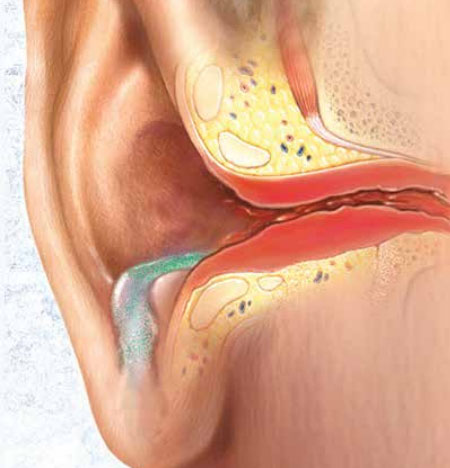Infection of the middle ear, or otitis media, is the most common affliction requiring medical therapy for children younger than five years.
ARE THERE RISK FACTORS FOR DEVELOPING AN EAR INFECTION?
- frequent upper respiratory infections
- attending daycare bottle-feeding increases the incidence compared to breast-feeding
- pacifiers increase the risk
- smoking in the household
- family history of ear infections
- brothers or sisters with recurrent ear infections
WHY ARE CHILDREN SO PRONE TO EAR INFECTIONS?
The Eustachian tube (the connection between the back of the nose and the ear) tends to not
function properly in many children. The function of the Eustachian tube is to clear the infection from the ear and keep the middle ear free of fluid.

Acute otitis media usually happens as a complication of a viral upper respiratory infection (URI) that the child has had. The secretions and inflammation cause a relative occlusion of the Eustachian tube.
Fluid forms in the middle ear as a result of the obstruction. This effusion in the middle ear provides a fertile place for bacteria and viruses to grow. The end result is an ear infection.
WHAT ARE THE SYMPTOMS OF OTITIS MEDIA?
Children who can talk usually describe feelings of pain or discomfort in the affected ear. Infants may have no symptoms except for increased irritability.
A doctor can diagnose otitis media by examining the child’s ear with a special instrument called an otoscope. Through the otoscope the doctor can see the tympanic membrane (ear drum), which is red or inflamed and possibly bulging.
Serious complications are rare.
HOW ARE EAR INFECTIONS TREATED?
Infants younger than six months should receive antibiotics. Children aged six months to two years should receive antibiotics if the diagnosis is certain and if the illness is severe. A waiting period to observe the child is an option when it’s not certain that the child has an ear infection, or when the diagnosis is certain but the infection is not severe.
The observation option is a 48- to 72-hour period of treating the symptoms with analgesics and without antibiotics, followed by examining the child again. To choose the observation option, a parent must have access to communicate with the doctor and have access to follow-up care if and when problems come up or their child’s symptoms get worse.
Pain management is an important part of treating ear infections, especially in the first 24 hours.
The child should be given appropriate analgesics.
IS FOLLOW-UP CARE NECESSARY?
Most cases of otitis media are self-limited. The incidence of complications is significant enough that all patients should have a follow-up visit with their regular doctor or clinic 14 to 21 days after the initial visit.
Any child with persistent pain or fever should be reexamined within 48 hours.
The outcomes for children with acute ear infections (otitis media) are excellent. Parents should make sure to finish the prescribed medication and bring their child in for their follow-up appointment.



